MusicRadar Verdict
More than just a drum machine, Maschine represents a whole new world for hands-on beat makers.
Pros
- +
Well-built hardware. Comprehensive mouse-less software control. 5GB of samples and loops.
Cons
- -
You can't use it to sequence external MIDI gear. No REX support.
MusicRadar's got your back

Native Instruments Maschine

Native Instruments Maschine

Native Instruments Maschine

Native Instruments Maschine
Although Native Instruments has produced hybrid hardware/software products in the past (notably Kore and Guitar Rig), Maschine represents an ambitious step forward.
With every feature of the software built into the impressive MPC-like desktop controller, it's easy to forget that the real power of Maschine lies at the other end of the USB cable within your computer. So, is Maschine hardware and software in perfect harmony?
Overview
First, it's important to get your head around what exactly Maschine is. It's billed as a groove production studio for your computer and to this end, it comes with a huge library of drum kits, loops and instrument presets, plus an environment to process, sample and sequence them into patterns and songs.
The hardware element is a USB-powered controller (not an audio interface), which is used for anything tactile while all the 'sounds stuff' is done by the software. The software interface is great, but the screens and controls on the hardware make it impressively redundant.
NI provides separate DVD installer disks for Mac and PC users and you can choose to install the software, plug-in (VST, AU, RTAS) and library, which will take around 10-20 minutes depending on your drive speed.
The library is meticulously organised and tagged (as you would expect from the inventors of Kore) and you can browse for complete kits or individual sounds. These include all kinds of instruments as well as drums and sound effects, elevating the Maschine beyond a mere 'beatbox'. Everything can be saved: kits, effects, songs, the works.
The controller
The hybrid metal/plastic enclosure of the Maschine hardware is slim and light, perfect for partnering with a laptop and slotting into a backpack for gigs. The jet-black paintwork has a minimal amount of labelling and graphics, giving it an uncluttered, stealth-like appearance we love.
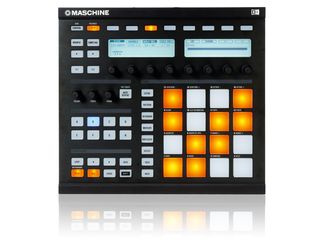
All the buttons are made from the same rubbery plastic and benefit from under lighting. The pads are similar to those on Korg's padKontrol, but chunkier. They are a tiny bit smaller than an MPC's and have a higher profile too, but feel similarly 'stern' and serious.
The two-level lighting is a nice touch. The faint glow means you can always aim for the pads, while the bright glow shows you which beats are being triggered by the sequencer.
The dual LCD displays, meanwhile, are flanked by a set of eight buttons and endless encoders. These feel nice and solid and are used for most of the editing jobs as well as live performance.
Round the back there's a pair of MIDI sockets for hooking up other gear. When the Maschine hardware is connected to a computer, the ports show up as a regular MIDI interface in audio applications.
However, it's important to note that, currently, the Maschine software can't send its internal sequences as MIDI messages so it can't trigger your external gear over MIDI (though we have heard a rumour that this functionality could be added in the next significant update).
It's up to you to decide how much of a problem this is. It can output MIDI clock, operating as either master or slave, and you can attach a keyboard for playing the Maschine's instruments (there's also a special keyboard mode on the controller for note-based play).
MIDI mode
All those knobs, buttons and pads can be put to good use with the rest of your studio gear by switching Maschine into MIDI control mode. Pressing the shift and control buttons will get your there, and the lights and display follow suit and disengage from their Maschine functions.
Bizarrely, the manual makes almost no mention of this, aside from pointing to the control button, so a bit of exploration was necessary.
There are 10 pre-programmed templates, which cover general MIDI control as well as a selection of NI's instruments, Traktor Pro, Ableton Live and Mackie HUI. You can make your own in the Controller Editor that installs with the main Maschine software.
The pads dish out velocity sensitive MIDI note messages, starting at C-1. The group buttons also transmit Note messages, but also act as octave buttons for transposing the pads up and down.
The knobs all transmit MIDI CC messages, as do almost all the others, save for the two arrow buttons. These swap between two control layers for doubling up the amount controls for the eight knobs and buttons around the LCD.
You don't need to have the Maschine software running to use MIDI control mode.
How does it work?
In essence, Maschine is an eight-track sequencer which can use up to eight separate kits or instruments. Users can build up a track, starting by constructing individual instrument patterns, which are the smallest building block.
You can then start layering patterns from the different kits/instruments into a scene, and then arrange up to 64 scenes into a song. Each sequencer track uses a 'group', which could be a drum kit, instrument or selection of single hits.
A drum kit consists of up to 16 individual 'sounds', which are assigned to individual pads for programming. However, you are not limited to one sample per pad, because a sound can use several samples. These can be arranged across velocity layers for expressive results.
The layering is not as sophisticated as in Battery, but we were pleasantly surprised to find that a pad could also be played chromatically by switching to keyboard mode. This means you can layer samples across a keyboard, with different samples on every key.
You can only add new layers via the software, and not the hardware controller, but given the advantages of a big display and mouse - why wouldn't you? This is where you begin to get a feel for the workflow, and what tasks are better suited to the computer and the controller. The division of labour between the two feels spot on.
Back to sequencing side, you can create up to 64 different patterns per group (16 patterns each in four banks), and patterns have a maximum length of 256 bars. All lengths can be accommodated and the time signature is set at global level.
Creating beats is nice and easy. There's a built in metronome and auto-quantising for real old-skool drum machine instant results. Notes can be hard quantised or gradually by steps of 50%, while erasing is performed by pressing record and holding down the offending pad. Just like the old days.
There's no need to ever stop while recording patterns, switching groups, or loading new sounds, either. The pads have an extra programming mode for multiple samples on pads.
If you're not up to playing your beats (despite all the auto assistance) your next option is to program in step mode, whereby each pad represents one step of the pattern (as on an old-school drum machine). The backlighting switches intelligently to show you the steps and sequence position.
Beyond basic sequencing, Maschine offers a massive amount of scope for editing and parameter automation. These can be tweaked and recorded in real-time or through the software interface.
Sampling
Got your head around it so far? Well, let's take it to the next level. Once you have a killer loop, you might want to re-sample it. Maschine can do this, rendering a pattern to a single loop for manipulation, and you can add your own sounds by sampling them through your audio interface inputs or through the plug-in's virtual input in your DAW.
Tools such as Auto Beat Length make the job faster and more streamlined and the hardware has all the controls necessary to get the job done. Just set the start and end points and you've got new sounds in no time.
For loop junkies and remixers, beat slicing is an essential tool for speeding up the process of getting individual hits from a loop and into a new groove. Maschine has a set of internal slicing tools that are accessed via the Sampling view button.
The plug-in window is the best way to use these: it shows the waveform and the slice regions. Two modes are available - transients and 16ths - and Maschine will try to calculate a BPM automatically. However, you can also set it manually.
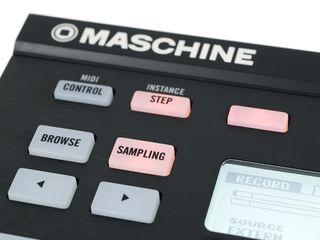
At this point, we should say that it's essential to download Maschine's OS 1.02, or you won't have these options. Currently, a gripe that remains is that if you need to slice your loops to anything other than 16ths, you'll need to work around by doubling or halving the tempo to get the right size chunk.
It's frustrating that you can't manually move markers before slicing, but you can after using the 'Apply to' function. This puts each beat on a pad, where you can manually adjust each start and end point.
Before we move one, we have to mention one bizarre omission: REX file support. Maybe in a software update?
Swing
As the emphasis is on live beat programming, the swing and quantise functions are essential humanising tools. Swing can be applied at two different levels of hierarchy. This can be on a part-by-part basis or as a global function. This is so that individual parts can sit in their own groove, or the whole track can swing together.
To avoid confusion, the global swing has a dedicated knob located next to the volume and tempo dials, while the part swing value is edited via the LCD.
The feel of the swing is a very important part of a drum machine's personality and part of the reason why the MPC has become such a legend. Maschine doesn't try to emulate the MPC here - instead, it offers an interesting twist to explore. Swing can be applied as a percentage where 0% is straight, 50% is very funky and 100% pushes the notes all the way over.
This is where Cycle comes in. By default, this is set to the highest value of 8th notes, which gives us the typical feel we know and love, but it doesn't stop there. You can set this to any value, which will give you a whole lot of different feels and can be both an outlandish creative tool as well as humanising.
The third parameter is Invert. This changes the direction of the shuffle so that instead of making it lazier, it pushes the beats forward providing a different emphasis. Neat.
The software
By now, you're probably realising that the real power of Maschine lies in its software interface. It may seem less glamorous than the hardware, and some might wonder why it needs to be there at all, but rest assured that it's damn good.
There are three main areas to the window: The Scene area at the top; the Editing section in the middle; and the Pattern sequencer at the base.
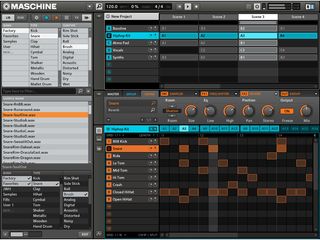
There's also a sound Browser that can be toggled out of sight when not in use, and the whole window can be re-sized to fit your monitor. One good thing about the pattern editor is that it's zoomable so you can resize it, but we would also like to see a kind of snap-to-fit button for maximising the area match to your pattern length.
For most jobs you can choose to use either approach, but there are some functions, such as creating zone layers, that are done exclusively through software. Personally, we don't mind this, as we prefer to use the computer for 'important' jobs anyway.
Another area where the computer rules is tidying up patterns - especially parameter modulation sequences. Using the editor you can get right in and always get just the right setting locked at every step, something that's quite difficult to do live. Speaking of live, if you like to mix in some 'impossible to perform' beats, then having the editor around to spice things up is essential.
DAW integration
While we're sure that a fair percentage will use Maschine as a complete solution, there are plenty of others who are searching for the ultimate drum machine to work within their existing software. Since Maschine is being offered as a plug-in, integration in this scenario is just as important, if not more so, than the standalone functionality.
Coming from standalone mode, 'Maschine in your DAW' can open up a previously saved project and let you carry on from where you left off. All sounds, patterns, settings etc are ready for tweaking and Maschine will follow the host tempo.
It's worth noting that Maschine's transport controls can't be used to operate the DAW and there are no automation parameters available in the host sequencer aside from the basic volume, pan, send etc.
At present, Maschine uses its internal scene memory for playback along the timeline, and there's no way to record scene or pattern changes from the controller into the sequencer. This is a bit of a shame, as it would be great to see a kind of dual mode whereby users can choose whether to go that route, or use MIDI to trigger scenes/patterns via their host.
It's necessary to arrange the patterns into scenes and then to set the loop point to mark the start and end of the sequence. One problem is that Maschine can't play an empty scene and will jump to the next part, so you will need to use an empty pattern of the right length to fill up the space.
You can take advantage of multiple outs to add more effects polish to the mix and, as a bonus, use Maschine as a crazy effects unit by routing audio to its sample inputs and automate changes using its internal sequencer.
Conclusions
There's no doubt that Maschine is much more than a powerful drum machine. While it's possible to launch right in and start making basic beats, it will take a bit of time to get used to the big picture, especially when it comes to taking advantage of all the more advanced features and their creative potential.
The combination of hardware and software is best exploited by thinking about what each element does well. The hardware is there to give you the feel of rhythm programming, and all the essential stuff can be accessed within a couple of button presses.
The software supports everything by offering all the hardcore editing functions through an interface that presents a bigger picture than LCD displays will. And let's not forget the massive library of sounds that comes with Maschine, making it a worthy 'all-in-one' studio solution (albeit one that's clearly focussed on beat production).
All of which puts Maschine squarely in Akai MPC territory. That said, it can't be used as the centrepiece of a studio since there's no way to sequence external MIDI gear from its software. As for that other MPC plus, the lack of any software-induced latency, this is down to your audio interface and drivers, but we're confident that Maschine can hold its own.
And one area where Maschine definitely comes out on top is that of effects. If you want up-to-date, tempo sync'd, high-quality processing then you've come to the right place. When combined with real-time tweaking, the mangling and transformation possibilities are phenomenal.
Maschine is always loads of fun to play, too, and as a self-contained instrument is capable of producing a huge range of tracks - from big, fat, lazy hip hop jams, to intricate and futuristic techno.
As a standalone system, Maschine is tight and works very well. The software side could certainly be improved with some refinements, but the extra features already added in the OS 1.02 update show that this product can be as flexible and all-powerful as Native Instruments wants it to be.
Ultimately, Maschine blends hardware and software to great effect, and gives you an impressive new way to make music.
Here are just some of the sounds from the Maschine library:
Future Music is the number one magazine for today's producers. Packed with technique and technology we'll help you make great new music. All-access artist interviews, in-depth gear reviews, essential production tutorials and much more. Every marvellous monthly edition features reliable reviews of the latest and greatest hardware and software technology and techniques, unparalleled advice, in-depth interviews, sensational free samples and so much more to improve the experience and outcome of your music-making.
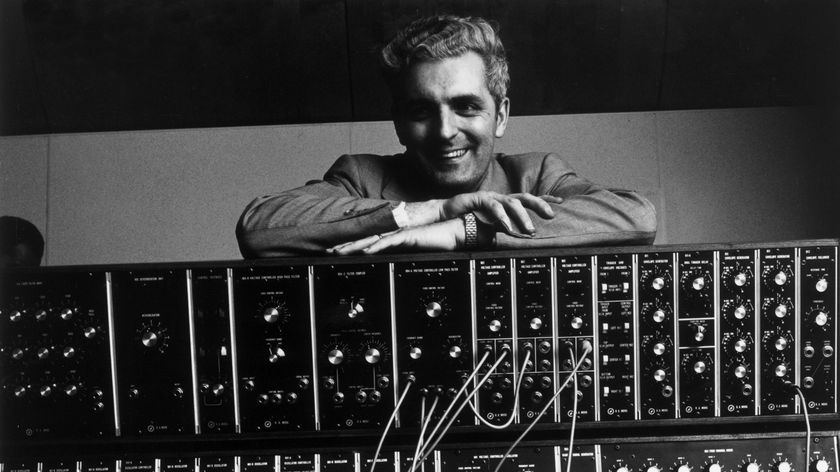
"The next generation of Moog products will push boundaries while remaining deeply rooted in the craftsmanship and creativity that defines the brand": Moog at 60, from the ladder filter to the Labyrinth
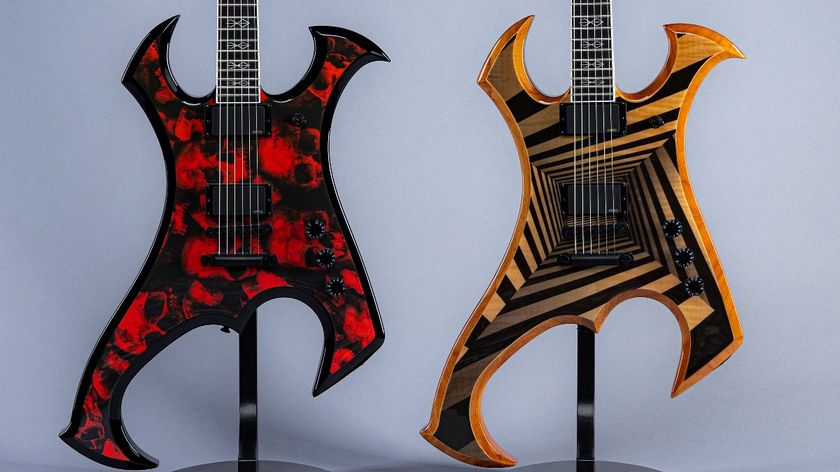
“Crafted for the true metal enthusiast, this axe embodies the soul of legendary guitarist Zakk Wylde”: Paging all “shred warriors,” Wylde Audio’s Berzerker takes the shape of metal guitars to new extremes
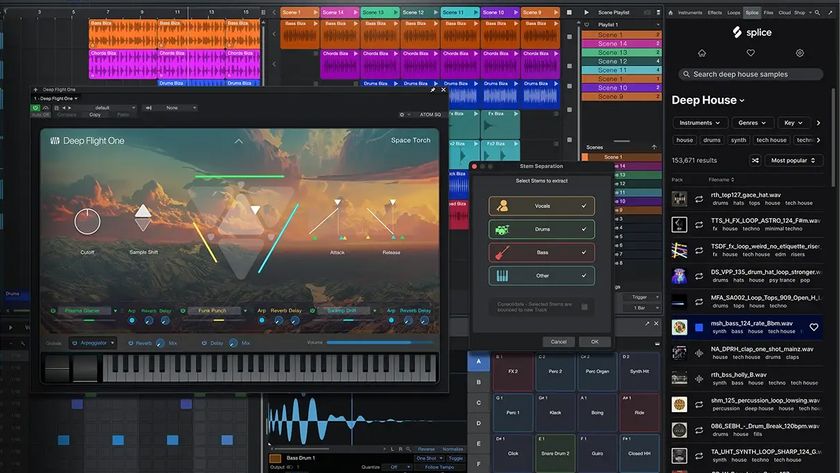
"An upgrade that’s all about creativity": PreSonus Studio One Pro 7 review
Most Popular






